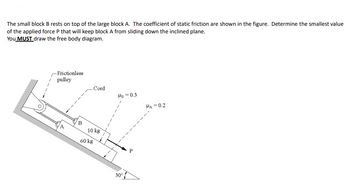Question

Transcribed Image Text:The small block B rests on top of the large block A. The coefficient of static friction are shown in the figure. Determine the smallest value
of the applied force P that will keep block A from sliding down the inclined plane.
You MUST draw the free body diagram.
-Frictionless
pulley
B
Cord
10 kg
60 kg
HB=0.3
30°
P
HA=0.2
Expert Solution
This question has been solved!
Explore an expertly crafted, step-by-step solution for a thorough understanding of key concepts.
This is a popular solution
Trending nowThis is a popular solution!
Step by stepSolved in 2 steps with 1 images

Knowledge Booster
Similar questions
- In the figure, block A (mass 13.2 kg) is in equilibrium, but it would slip if block B (mass 7.40 kg) were any heavier. For angle 0 = 29.6°, what is the coefficient of static friction between block A and the surface below it? Number i Unitsarrow_forwardDetermine two force members first. Two blocks are each pin connected to a massless horizontal link. Determine the largest P before motion cocurs. Use 0.35 and 0.3 for the friction coefficients. 45° J c 4.5 kg 3 kg B 30°arrow_forwardGOAL Apply the concept of static friction to an object resting on an incline. PROBLEM Suppose a block with a mass of 2.50 kg is resting on a ramp. If the coefficient of static friction between the block and ramp is ng sin e 0.350, what maximum angle can the ramp make with the horizontal mg cos e e before the block starts to slip down? STRATEGY This is an application of Newton's second law involving an object in equilibrium. Choose tilted coordinates, as in the figure. Use the fact that the block is just about to slip when the force of static friction takes its maximum value, f. = 4n. SOLUTION Write Newton's laws for a static system (1) EF = mg sin e - u̟n = 0 in component form. The gravity force (2) EF = n - mg cos e = 0 has two components. Rearrange Equation (2) to get an n = mg cos 8 expression for the normal force n. Substitute the expression for n into EF, = mg sin 8 - H mgcos 0 = 0 → tan 8 =u. Equation (1) and solve for tan 0. Apply the inverse tangent function to get the answer.…arrow_forward
- F 0 EC FAC $ Ed and Al are pushing on a couch as shown in the picture and it doesn't slip. Ed is pushing with a force of 198.9 N at an angle of 0 = 54 degrees with respect to the vertical and Al is pushing with a force of 60.2 N at an angle of = 35.4 degrees with respect to the horizontal. If the couch has a mass of 83 kg and the coefficients of static and kinetic friction between the couch and the floor are μg = 0.53, and k = 0.39, what is the magnitude of the force of friction exerted by the floor on the couch? Click here for a hint Farrow_forwardA 37 N block rests on an inclined plane with a slope of 25°. What is the normal force acting on the block?arrow_forwardBlocks A and B each have a mass m = 15 kg. The coefficient of static friction between A and B is μg = 0.28. The angle shown is 0 = 47°. Neglect any friction between B and C. A B P C Determine the largest horizontal force P that can be applied so that A will not slip on B. P= number (rtol=0.05, atol=1e-08) Narrow_forward
arrow_back_ios
arrow_forward_ios